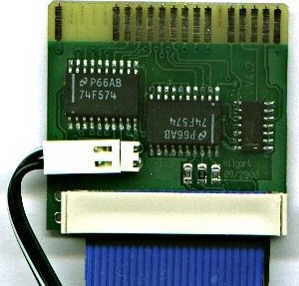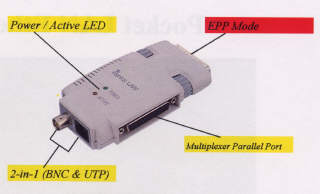
This project had the target of giving LAN access to even the lowest Atari computer. The components already in the computer were not suitable for this purpose, with the exception of the ROM port. This is because this method will work with older computers like 520st with TOS 1.02, with STinG loaded from floppy disk, all the way up to the TT or Falcon to work together in a LAN.
 First to be described is the hardware, which consists
of two sections.
First to be described is the hardware, which consists
of two sections.
The parallel port interface, which is plugged
into the ROM port and provides a parallel port for the pocket LAN adapter.
The circuit is constructed with SMD chips, which makes it very small. The
contacts for the ROM port are protected from contact problems caused by
oxidation. The only problem is that the adaptor circuit board is not attached
or bolted on. The user must make sure that the circut board is not inadvertently
pulled out of the ROM port by the ethernet cable.
This picture shows the new version of the ROM port interface with the power supply for the LAN adapter and so does not need the external plug power pack any more.
Additionally there will be a special "tower version", which will have a longer ribbon cable. The SUB-D socket can then be screwed onto the rear wall of the Towers case, so the pocket lan adapter can be plugged into the outside of the case. Of course there must be sufficient free space for the socket.
 The LAN adapter we are using is the E3000II Model.
It has both BNC and UTP links. The multiplexer parallel port on the LAN
adaptor cannot be used on Atari computers. Other Lan adapters with RTL
8012 chip should also work but to my knowledge the E3000II is the only
one.
The LAN adapter we are using is the E3000II Model.
It has both BNC and UTP links. The multiplexer parallel port on the LAN
adaptor cannot be used on Atari computers. Other Lan adapters with RTL
8012 chip should also work but to my knowledge the E3000II is the only
one.
The computer provides the power for the LAN adapter (with the new circuit
board version) or is supplied with a separate power supply. Measurements
of the power drain have shown that the ROM port can safely supply the power
without problems. With the tower version, where the pocket LAN adapter
is fastened from the outside, you have to use the external power supply.
Now to the software.
There are drivers for STinG that run under MagiC or TOS, come from
Vassilis Papathanassiou and
are Freeware. Thanks to Vassilis for doing the work.
STinG Version 1.26 is recommended.
Note: the software are on a HD-Disk, if you need a DD-Disk let me know.
MiNTNet driver available.
Benchmarks:
Testkonfiguration: Atari TT030 with MagiC. FTP-Server on a PC.
| Client | Download | Upload |
| Newsie | ca. 64kByte/s | ca. 30kByte/s |
| aFTP1.4b4 | ca. 93kByte/s | ca. 36kByte/s |
| aFTP1.55b | ca. 7,5kByte/s?? | ca. 78kByte/s |
Software (of different authors)
(look for updates)
Elmar Hilgart
-
MACInfo, a program to read out the MAC-Adress and the hardware-revision of the ROM-Port interface. Usefull for tests.

MACInfo - Version 1.2 - 15.01.2001, 24.203 Bytes
Ronald Andersson
- STinG 1,26 complete: sting126.lzh, 435,541 bytes
- aftp a FTP Client: aftp155b.zip, 143,113 bytes
- BNet, a network often commodity for Ataris. Runs under MagiC and TOS: bnet303b.zip, 36.985 Bytes
-
Ftp server for STinG, STiK and GlueSTiK: ftp_serv.zip (v 1.09), 42.824 Bytes

-
EtherNet pocket LAN adapter:
- Driver and connection diagram: ether_pa.zip (v 1.06), 29.855 Bytes

- Driver Sourcen: eth_src.zip (v 1.06), 22.164 Bytes

- New driver for MiNTNet. RTL8012X.ZIP (v 1.3), 3.326 Bytes

- Driver and connection diagram: ether_pa.zip (v 1.06), 29.855 Bytes
- MagiCNet and driver for Pocket-LAN Adapter
Finn Bastiansen
- German STinG Documentation. No longer up-to-date, but a great help.
- HTML version: stngddok.lzh, 33,439 bytes
- ST Guide version: stdokhyp.lzh, 28,763 bytes

![]()
"I recommend the ROM-Port Ethernet Link, it's good value." - Shiuming Lai, MyAtari Jan 2001